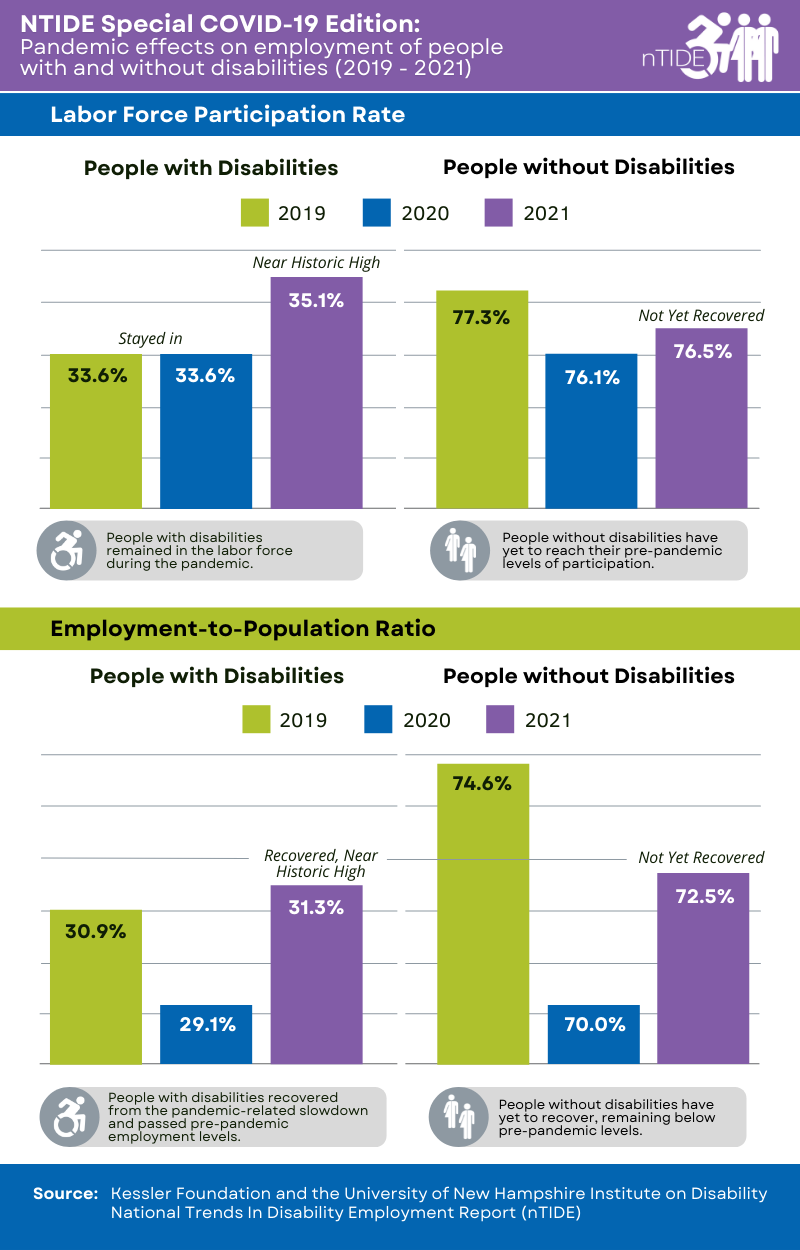Experts examine stark contrasts in recovery between people with and without disabilities in National Trends in Disability Employment (nTIDE) Special Edition 2019-2021
East Hanover, NJ. February 28, 2022. At the start of 2022, as the acute phase of the COVID-19 pandemic began to subside and public health efforts continued, experts reflected on the pandemic’s impact on employment in the U.S. This special edition of National Trends in Disability Employment (nTIDE) presents data from 2019 through 2021 for people with and without disabilities, showing stark contrasts in their progression from pre-pandemic employment levels of 2019, the impact of 2020 lockdowns, followed by the beginnings of recovery in 2021.

showing people with disabilities have recovered from pandemic lows and exceeded pre-pandemic
employment levels, while people without disabilities have yet to recover
The data show that people with disabilities have not only recovered from the setbacks of 2020 lockdowns, but they have also exceeded pre-pandemic levels of employment to reach new historic highs. This contrasts with their counterparts without disabilities who have yet to reach their pre-pandemic levels of employment.
As the top graphic shows, in 2019 and 2020, the labor force participation rate remained the same for people with disabilities (33.6%), rising to 35.1% in 2021. “Despite the disruption of the pandemic, people with disabilities stayed engaged in the labor market, meaning they were working, on furlough, or looking for work” explained nTIDE co-author Andrew Houtenville, PhD, professor of economics and research director of the University of New Hampshire Institute on Disability. In 2021, participation rose above pre-pandemic levels to 35.1%, exceeding the historic high seen in 2008 around the start of the Great Recession. “This may be a sign that people with disabilities are taking advantage of new job opportunities in the tight labor market,” added Dr. Houtenville. “Necessity may also be a factor in sustained participation, as workers with disabilities may be less able to forego their income.”
For people without disabilities, labor force participation rate dropped from 77.3% in 2019 to 76.1% in 2020, rising to 76.5% in 2021, still well below pre-pandemic levels. “They are returning slowly to the labor market,” noted Dr. Houtenville, “and have yet to recover the ground they lost in 2020.”
In the bottom graphic, the comparison of employment to population ratios tells a similar story of resilience. In 2019, the employment population ratio was 30.9% for people with disabilities, dropping to 29.1% in 2020, then surpassing pre-pandemic levels, rising to 31.3% in 2021. “Again, not only did people with disabilities recover, but they also exceeded their pre-pandemic levels, approaching historic highs.” In contrast, the employment-to-population ratio for people without disabilities declined from 74.6% in 2019 to 70.0% in 2020, reaching only 72.5% in 2021.
These stark contrasts are fascinating findings, according to nTIDE co-author John O’Neill, PhD, director of the Center for Employment and Disability Research at Kessler Foundation. “It really is a story of true grit. On the whole, despite the stresses of the pandemic, people with disabilities stayed in the labor force, a pattern we hope to see continue as the pandemic evolves,” he emphasized. “It’s also crucial that we ensure that the hard-won gains achieved by workers with disabilities are sustainable as people without disabilities continue to return to the labor force. That will require concerted efforts by advocates, workers, employers, vocational rehabilitation professionals, and other stakeholders.”
Drs. Houtenville and O’Neill discuss how people with disabilities are dealing with the pandemic’s impact on jobs in this 2022 podcast:
Stream 2021 nTIDE Year In Review - A Story Of True Grit by Kessler Foundation | Listen online for free on SoundCloud
Upcoming nTIDE releases are scheduled for March 4 and March 18.
National Trends in Disability Employment (nTIDE) reports are released semi-monthly by Kessler Foundation and the University of New Hampshire Institute on Disability. These custom reports are based on data released by the Bureau of Labor Statistics. Each nTIDE release is followed by a nTIDE Lunch & Learn webinar. This live broadcast, hosted via Zoom Webinar, offers attendees Q&A on the latest nTIDE findings, provides news and updates from the field, as well as invited panelists to discuss current disability-related findings and events. Join live or visit the archives at: ResearchonDisability.org/nTIDE.
NOTE: The statistics in nTIDE are based on Bureau of Labor Statistics numbers but are not identical. They are customized by UNH to combine the statistics for men and women of working age (16 to 64). nTIDE is funded, in part, by grants from the National Institute on Disability, Independent Living and Rehabilitation Research (NIDILRR) (90RT5037) and Kessler Foundation.
About Kessler Foundation
Kessler Foundation, a major nonprofit organization in the field of disability, is a global leader in rehabilitation research that seeks to improve cognition, mobility, and long-term outcomes -- including employment -- for people with neurological disabilities caused by diseases and injuries of the brain and spinal cord. Kessler Foundation leads the nation in funding innovative programs that expand opportunities for employment for people with disabilities.
About the Institute on Disability at the University of New Hampshire
The Institute on Disability (IOD) at the University of New Hampshire (UNH) was established in 1987 to provide a coherent university-based focus for the improvement of knowledge, policies, and practices related to the lives of persons with disabilities and their families. For information on the NIDILRR-funded Employment Policy and Measurement Rehabilitation Research and Training Center, visit ResearchOnDisability.org.
Interested in trends on disability employment? Contact Carolann Murphy to arrange an interview with our experts: 973.324.8382
[email protected]
Twitter | Facebook | YouTube | Instagram | iTunes & SoundCloud